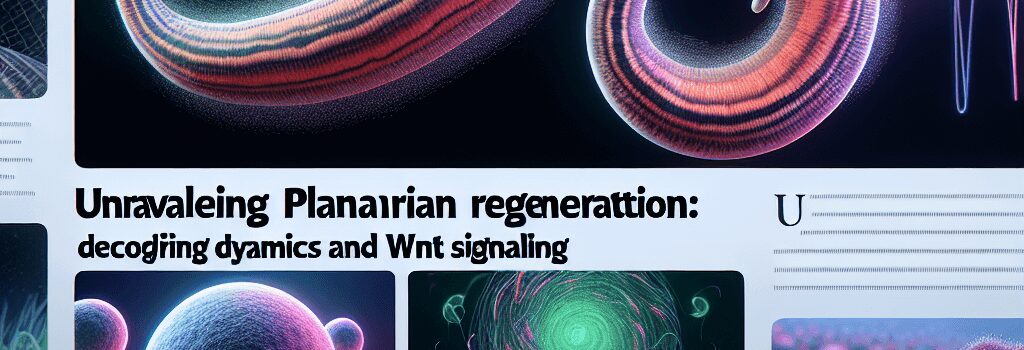Unraveling Planarian Regeneration: Decoding Tail Dynamics and Wnt Signaling

For many who remember high school biology, planarians immediately evoke images of remarkable regenerative capabilities. These flatworms can restore an entire head or tail from mere fragments, a process that re-engages developmental pathways usually active only during embryogenesis. Recent experiments have deepened our understanding of these processes, revealing that successful head regeneration depends critically on prior tail development and the dynamic interplay of signaling molecules such as wnt.
Establishing the Regenerative Blueprint
Planarians regenerate through the formation of a blastema—a cluster of pluripotent stem cells that develops at the site of injury. Under normal conditions, these cells receive cues from a complex signaling network. During embryonic development, the wnt family of proteins establishes the anterior-posterior (head-to-tail) axis by marking the posterior end of the organism. In regenerative contexts, the same molecules instruct the blastema to form tail structures. However, when the injury occurs early in development, while the canonical head-to-tail signaling is still active, the regenerative process becomes markedly more intricate.
Technical Insights on Wnt Signaling and Tissue Polarity
A series of experiments using the planarian species Schmidtea polychroa have provided vital clues. Researchers found that when embryos were bisected before a certain developmental milestone, the resulting fragments failed to seal their wounds and rapidly degenerated as cells leaked into the environment. In contrast, embryos cut slightly later could successfully seal wounds, allowing head fragments to regenerate a tail. This success indicates that the inherent mesenchymal signaling and wound-healing responses are closely linked with the maturation of wnt signaling pathways.
- Wnt Activity: The robust activity of wnt proteins in posterior fragments appears to inhibit the formation of new anterior structures (i.e., the head), unless wnt signaling is intentionally inhibited.
- Muscle Cells as Signaling Platforms: Muscle tissue in planarians acts not just as a structural support, but as a crucial communication hub for blastema formation and organizing the regenerating tissue. This role suggests that the appropriate density and maturity of muscle cells may be a prerequisite for successful head regeneration.
Experimental Approaches and Findings
To further dissect these mechanisms, researchers conducted an innovative two-step surgery on the embryos. Initially, they removed the tails, allowing a 24-hour interval before inducing a new wound at the anterior end of the tail fragment. Surprisingly, these delayed injuries could induce normal regeneration, with new head structures forming on the tail fragments. These observations offer a window into the time-sensitive processes that prime cells for regeneration, highlighting that certain cellular components (possibly muscle cells or their derivatives) appear in the tail region only after a critical developmental period.
Implications for Regenerative Medicine and Developmental Biology
The study’s findings have broad implications beyond planarians. By clarifying how reactivation of developmental pathways determines regeneration success, scientists can draw parallels with other species and even human tissue repair mechanisms. The controlled modulation of signaling pathways such as wnt is already a topic of intense research in regenerative medicine. Understanding the temporal dynamics of these cues might lead to improved methods for tissue engineering and recovery from injuries in more complex organisms.
Emerging Technologies and Future Directions
As the pace of biomedical innovation increases, future studies will likely integrate techniques from AI-driven image analysis to monitor cell behaviors in real-time during regeneration. Advanced gene editing tools, including CRISPR-based methods, may allow researchers to manipulate specific pathways like wnt with higher precision. Such approaches will propel our understanding of developmental signals and may eventually pave the way for leveraging regenerative processes in clinical settings.
Expert Opinions and Broader Context
Leading experts in regenerative biology emphasize the importance of dissecting these molecular pathways. Dr. Elaine Rivers, a developmental biologist at the Institute for Regenerative Medicine, notes that “tail dynamics and the sequential appearance of critical muscle cells represent a missing link in our comprehension of tissue regeneration.” This sentiment is echoed by computational biologists who foresee future collaborations between regenerative biology and machine learning for high-throughput screening of gene expression changes during regeneration. Such interdisciplinary ventures are likely to unlock new paradigms in both basic science and applied clinical treatments.
Overall, the research underscores a central tenet of regenerative biology: in order to restore the head, the tail must first be fully developed. This intricate timing and spatial coordination between different tissues not only illustrates the complexity of biological organization but also opens new avenues for innovative regenerative therapies.